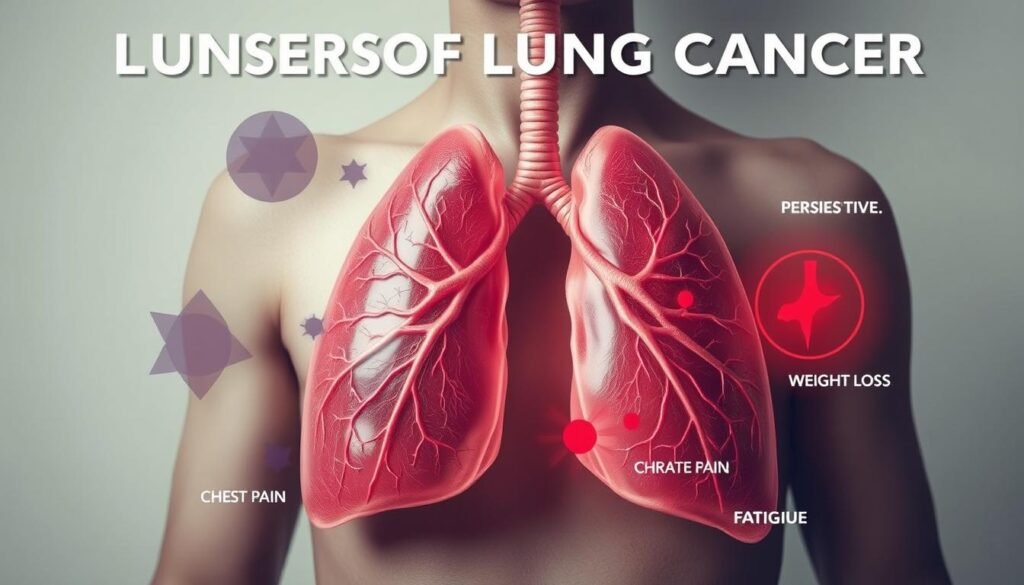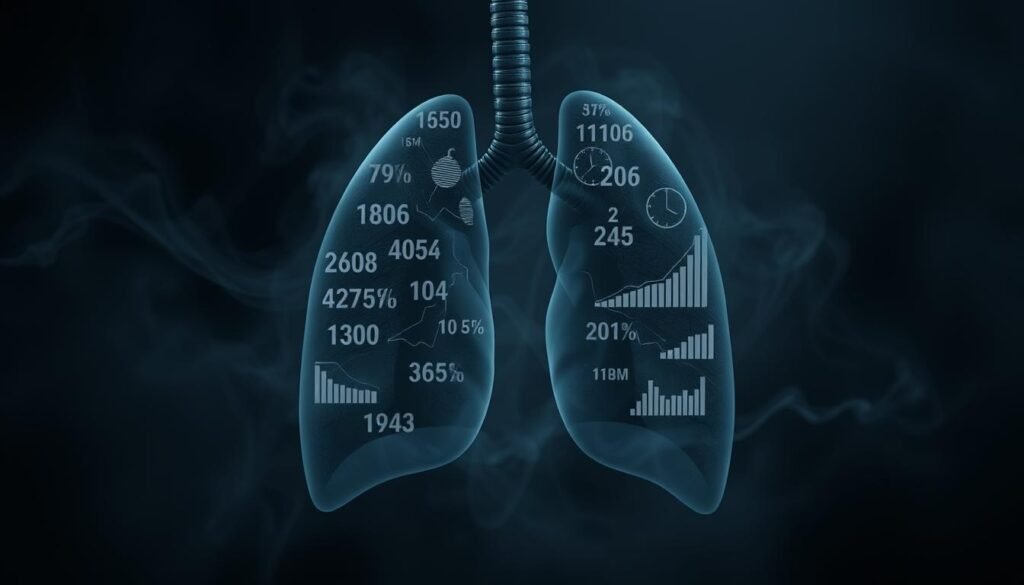Lung cancer leads in causing cancer-related deaths in the US, being 25% of all cancer deaths. The 5-year survival rate is low, at 3% for small cell lung cancer and 8% for non-small cell lung cancer (NSCLC). The question, What Happens If Metastatic Lung Cancer Goes Untreated? is vital for patients, their families, and doctors. Not treating this aggressive cancer can result in rapid health decline and poor life quality.
Without treatment, lung cancer’s outcome gets worse quickly. Statistics show about 25-30% of people with advanced NSCLC might live less than 3 months. Highlighting the fast growth of lung cancer without treatment helps us understand its impact on survival and well-being.
Key Takeaways
- Lung cancer is responsible for 25% of cancer deaths.
- The 5-year survival rate for small cell lung cancer is only 3%.
- Up to 30% of metastatic NSCLC patients may expect less than 3 months to live.
- Survival rates improve with early detection and treatment.
- Quality of life severely declines in untreated metastatic lung cancer.
- Understanding lung cancer progression is essential for patients and their families.
Understanding Metastatic Lung Cancer
Metastatic lung cancer is when cancer cells move from the lungs to other body parts. This process is called metastasis. It can be local, spreading to nearby tissues, regional, to areas in the same region, or distant, where tumors form far from the original site.
Doctors classify metastatic cancer by how far it has spread. Micrometastasis means a few cancer cells have spread but can’t be seen on scans. Macrometastasis means there’s a bigger spread. Knowing this helps doctors figure out the cancer stage.
Most lung cancers are called carcinomas. The main types are non-small cell lung cancer (NSCLC) and small cell lung cancer (SCLC). NSCLC, which is most lung cancer cases, grows slower. SCLC spreads fast and grows quickly. Knowing the lung cancer stages helps doctors plan treatment.
Sometimes, cancer can come back in a new place, called metastatic recurrence. There can also be a second, unrelated cancer. This makes treatment more complex.
Stages of Lung Cancer and Their Implications
Lung cancer has different stages, each important for treatment and outlook. Knowing the stages helps understand outcomes and make better care decisions. Early lung cancer stages have better recovery chances than advanced stages.
Stage I: Early Detection and Outcomes
Stage I lung cancer offers hopeful results. Survival rates can be as high as almost 65%. This is because the cancer hasn’t spread beyond the lungs. Early detection plays a key role in successful treatment.
Regular screening helps catch the disease early. This improves the chances of overcoming lung cancer significantly.
Stage IV: Advanced Metastatic Lung Cancer
Stage IV lung cancer is more severe. It has spread to distant organs. Unfortunately, survival rates are low, around 5% over five years.
The average life span without treatment is about 7 months for non-small cell lung cancer. However, treatments like chemotherapy and immunotherapy can sometimes extend life. Their success varies with each patient.
| Stage | 5-Year Survival Rate | Average Life Expectancy Without Treatment |
|---|---|---|
| Stage I | ~65% | N/A |
| Stage II | ~40% | N/A |
| Stage III | ~15% | N/A |
| Stage IV | ~5% | ~7 months |
At the last stage, palliative care is crucial. It helps manage symptoms and maintain life quality. Support covers emotional and psychological needs during tough times. Understanding lung cancer’s stages is key to better treatment and patient experiences.
What Happens If Metastatic Lung Cancer Goes Untreated?
Lung cancer getting worse without treatment leads to serious problems. The tumor grows fast in non-small cell lung cancer, often doubling in size every seven months. This causes big health issues like breathing problems, constant cough, and a lot of pain. Not treating lung cancer also hurts the quality of life and makes you weaker.
Lung Cancer Progression Without Treatment
Lung cancer gets more severe without treatment, going through stages, each worse than the last. At first, the symptoms might be mild. But soon, breathing gets hard and coughing up blood happens more. Cancer can spread to other key organs, making treatment harder and lowering chances of living longer.
Life Expectancy for Untreated Patients
How long someone can live with untreated lung cancer depends on the cancer type and how early it’s found. For non-small cell lung cancer, people might live five to twelve months. Those with small cell lung cancer often live between three to fifteen months. Age and other health problems also change these numbers, showing how crucial treatment is.
| Cancer Type | Average Life Expectancy (Untreated) | Stage Impact |
|---|---|---|
| Non-Small Cell Lung Cancer | 5 to 12 months | Worsening symptoms and increased size of tumors |
| Small Cell Lung Cancer | 3 to 15 months | Rapid decline, high likelihood of metastasis |
It’s crucial to understand how serious untreated lung cancer is. As the disease gets worse, not only does life expectancy drop, but life’s quality also gets much worse. This situation needs good medical care and support for both the patients and their families.
Symptoms of Advanced Lung Cancer
It is vital to know the symptoms of advanced lung cancer. This helps manage the disease and support the patient. Knowing what signs to look for can help families and caregivers. They can offer better care and comfort to their loved ones.
Common Signs of Metastatic Lung Cancer
Common symptoms of lung cancer include a persistent cough, weight loss, and tiredness. Patients may also find it hard to breathe as the cancer gets worse. This makes everyday tasks challenging. Other metastatic lung cancer symptoms include:
- Chest pain
- Coughing up blood
- Bone pain and weakness
- Swollen lymph nodes
Early recognition of these signs can improve care and management. This can make the patient’s experience better.
Terminal Lung Cancer Symptoms
When lung cancer is in its final stages, symptoms change. Patients might feel very tired, confused, and struggle to breathe. Common terminal lung cancer symptoms include:
- Noticeable changes in breathing
- Less appetite, stopping eating and drinking
- Skin color and temperature changes
- Energy spikes followed by deep sleep
This stage requires a lot of understanding and kindness. Families should seek help from hospice care professionals. They offer advice on dealing with these tough times.

| Symptom | Description |
|---|---|
| Persistent Cough | A lasting cough that may worsen or produce blood. |
| Weight Loss | Significant weight loss often occurs, even with adequate food intake. |
| Fatigue | Extreme tiredness persists, impacting daily activities. |
| Shortness of Breath | Difficulty in breathing that may require oxygen supplementation. |
| Confusion | Disorientation or changes in mental status can arise. |
Impact on Quality of Life with Untreated Lung Cancer
Untreated lung cancer can greatly affect your quality of life. It makes everyday tasks much harder. People with lung cancer face big challenges in daily life untreated lung cancer. They have trouble working, hanging out with friends, and doing everyday tasks. This disease limits what they can do on their own. It affects not just the patient but their family too.
Daily Life Challenges
Not treating lung cancer leads to big problems. Patients often feel very tired and have breathing problems and pain. About 98% of patients go through these issues. These problems:
- Make household chores difficult
- Keep people from keeping their jobs
- Limit time with friends
- Make getting medical help hard
Dealing with these issues every day can make patients lose hope and feel upset. This is especially hard for people who used to be very active.
Emotional and Mental Health Considerations
The mental toll of having untreated lung cancer is huge. The emotional impact lung cancer leads to a lot of fear and sadness for the patient and their loved ones. Getting mental health support is vital for dealing with this illness well.
- Patients often worry a lot about dying.
- Help from mental health experts can make things easier.
- Relatives may also face their own emotional challenges.
It’s important to understand and talk about the mental health untreated cancer issues patients and families face. Offering help and starting conversations about mental health can greatly help everyone involved.
| Impact Area | Description | Percentage Affected |
|---|---|---|
| Fatigue | Chronic tiredness that limits daily activities | 98% |
| Loss of Appetite | Reduced desire to eat leading to weight loss | 98% |
| Respiratory Problems | Difficulties in breathing and performing physical activities | 94% |
| Cough | Persistent and sometimes painful coughing | 93% |
| Pain | Chronic pain often related to metastasis | 90% |
Complications Associated with Advanced Lung Cancer
Advanced lung cancer comes with many complications that deeply affect health. If metastatic lung cancer is not treated, it leads to untreated cancer risks. This harms the body’s lung cancer vital organs a lot. So, understanding these complications is crucial.
Health Risks from Untreated Metastasis
Treating metastatic lung cancer late makes tumors grow unchecked. It also makes big health problems more likely. These risks include:
- Respiratory failure due to compromised lung function.
- Infections resulting from a weakened immune response, which may occur in up to 70% of patients.
- Venous thromboembolism, affecting about 3% of individuals, increasing the risk of life-threatening clots.
- Bone fractures and spinal cord compression, leading to serious mobility issues.
For more on these complications, check out metastatic lung cancer symptoms and management techniques.
Effects on Vital Organs
When cancer spreads, it attacks the body’s lung cancer vital organs, causing severe damage. The complications include:
| Vital Organ | Potential Complication |
|---|---|
| Liver | Metastatic spread leading to jaundice and liver failure. |
| Brain | Neurological deficits due to tumors causing pressure effects. |
| Lungs | Obstruction and poor gas exchange, causing severe hypoxia. |
| Bone | Pathological fractures and pain from metastatic invasion. |
Knowing about untreated advanced lung cancer’s impacts shows why quick action is key. This knowledge can guide decision-making for treatment strategies. Learn more from metastatic lung cancer.

Palliative Care for Lung Cancer Patients
Palliative care for lung cancer is crucial for enhancing life quality for patients. It is not just for the end of life. It begins at any point in the patient’s journey, tailored to their care goals.
Goals of Palliative Care
Palliative care aims to improve patient well-being in several ways. This care provides relief from pain and troubling symptoms like shortness of breath, nausea, and fatigue. It also offers emotional and psychological support for those feeling anxious or depressed due to lung cancer.
Additionally, it ensures coordinated care among healthcare teams. This includes doctors, nurses, and social workers. Importantly, it improves communication between patients and their healthcare providers. This allows patients to better understand their treatment options and symptom management strategies.
Support for Patients and Families
Support for cancer patients and their families is more than medical treatment. Cancer care programs provide counseling to help with emotional stress. They also offer support groups. These groups create a community among families facing similar challenges.
There are community resources too. They offer practical help with meals, transportation, and everyday tasks.
With comprehensive palliative care and support, lung cancer patients can face their illness with ease and dignity. This improves their overall quality of life.
Understanding Survival Rates Without Treatment
Survival rates for lung cancer are key for understanding what the future might hold. It’s important to grasp these stats, especially the differences between small cell lung cancer and non-small cell lung cancer. These differences in lung cancer survival statistics show the real impact of not getting treatment.
Statistics for Small Cell vs. Non-Small Cell Lung Cancer
Survival rates without treatment vary greatly by cancer type. Small cell lung cancer offers a grim outlook, with life spans ranging from 3 to 15 months post-diagnosis. On the other hand, those with non-small cell lung cancer can expect to live between 5 and 12 months, depending on when they were diagnosed.
The expected lifespan changes significantly with the stage of non-small cell lung cancer:
| Stage | Life Expectancy (Months) |
|---|---|
| Stage I | 13.7 |
| Stage II | 8.4 |
| Stage IIIA | 6.1 |
| Stage IV | 2.0 |
About 80% of lung cancer cases are found at late stages, greatly reducing survival chances without treatment. These facts underline the urgent need for awareness about surviving lung cancer.
Factors Affecting Survival Rates
Many factors impact how long people live with lung cancer. Age, health, cancer type, and genetic changes all play a big role. People found to have it early (Stage 1 and 2) often live much longer – between 33 to 55 months. In contrast, late-stage (Stage 4) patients’ lives are much shorter, averaging 4 to 9 months.
Knowing these factors helps people and their families make smart choices about treatment. Programs offering financial help for cancer treatment can support those struggling with these tough decisions.

Decision-Making: Treating Lung Cancer vs. Choosing to Forego Treatment
Choosing how to handle lung cancer treatment is hard. Some patients decide against it for different reasons. It’s important to understand why to see the big picture in oncology decisions.
Reasons to Choose No Treatment
Patients often skip treatment for reasons like:
- Quality of Life Considerations: Many prefer a better daily life over harsh treatments.
- Fear of Side Effects: Worrying about bad treatment reactions is common.
- Perceived Inefficacy: Not believing in treatment success can make patients feel hopeless.
- Loss of Control: Treatment can make people feel they’re losing grip on their health choices.
- Mental Health Issues: Anxiety and depression greatly affect the decision to avoid treatment.
- Financial Limitations: The high cost of treatment is often a major hurdle.
- Communication Issues: Bad talks with doctors can lead to doubts and treatment refusal.
Stats show less than 1% of lung cancer patients refuse all standard treatments. Between 3% and 19% may say no to chemotherapy, either in part or whole. Their choices are about wanting dignity and control towards life’s end.
The Role of Healthcare Providers in Decision Making
Doctors and nurses are key in making informed choices for lung cancer treatment. They should:
- Fostering Open Dialogue: It’s crucial to talk openly about treatments and what they entail.
- Respecting Patient Autonomy: Honoring treatment refusals builds trust with patients.
- Offering Support: Support helps counteract loneliness in patients who don’t want treatment.
- Discussing Palliative Care: Palliative care often meets patient desires for comfort and managing symptoms.
Health professionals must understand the tough choices patients face. Although it’s hard when patients go against advice, support is essential. Better communication can help guide these decisions in a positive direction.
End-Stage Lung Cancer Management
Managing end-stage lung cancer is about improving life quality for those in the disease’s final stages. It includes comfort care strategies. These strategies focus on easing pain and discomfort. They also offer emotional support for patients and families.
Symptom Management and Comfort Care
Symptom relief is vital in end-stage lung cancer management. The care team tackles many physical symptoms, such as:
- Pain control with medicines
- Help for breathing issues
- Counseling for emotional support
- Nutrition advice for better comfort
Studies show hospice care boosts life quality for patients and their families more than standard care. It shows the importance of holistic approaches in care plans.
Support Systems for End-Stage Patients
Support for end-stage cancer patients goes beyond just medical help. Hospice often starts in the last six months of life but can start earlier if needed. The stay in hospice usually lasts about 18 days. During this time, families feel more supported emotionally.
Hospice care includes:
| Service | Description |
|---|---|
| Medication Management | Managing pain and symptoms with the right drugs. |
| Physical Therapy | Exercises for mobility and wellbeing. |
| Nutritional Counseling | Advice on eating to reduce discomfort. |
| Emotional Support | Counseling for patients and their families. |
End-of-life doulas can offer valuable companionship and emotional support. Discussing care preferences with doctors is crucial. This way, people can make clear their end-of-life care wishes ahead of time.
Conclusion
Knowing about untreated metastatic lung cancer is key to get its full impact. The chance of surviving depends on the lung cancer type and how early it’s found. For example, the five-year relative survival rate for stage 4 non-small cell lung cancer is only 9%.
This shows the tough reality for patients facing untreated lung cancer outcomes. But, early detection and treatment can greatly raise survival chances.
Talking about untreated lung cancer outcomes also means looking at life quality. Without treatment, patients often struggle with physical and emotional hardships. It’s important to focus on care that improves comfort and dignity.
People making treatment decisions need clear information. This helps them choose what’s best for their situation and values.
Raising awareness and encouraging early screening are key to save lives. High-risk individuals should get screened early. This can lead to better treatment and survival rates.
For more on how lung cancer spreads, visit Medical News Today. Despite the tough journey, knowledge and support can truly help.